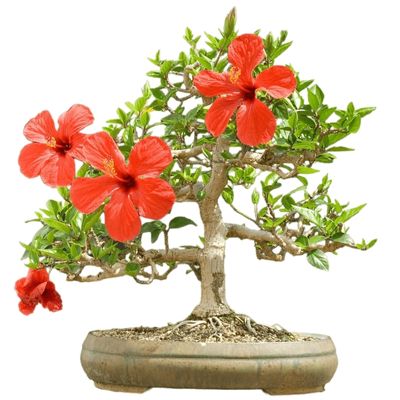
China rose / Chinese hibiscus
(Hibiscus rosa-sinensis)
Country of Origin : China
Bonsai Styles : Informal upright, group, slanting, semi-cascade
Zone : 6 – 9
China is believed to be the original home of this evergreen shrub (as the name suggests) found throughout the tropics. It grows as a small tree.
The tree has shiny, toothed, long, ovate and opposite leaves. It is not uncommon for these dark-green leaves to appear large for a bonsai.
A China rose bonsai is preferred for its large, papery, funnel-shaped flowers. The flowers come in many colors, ranging from white, red, yellow, and pink. Furthermore, there are also some plants that can produce dual-colored flowers.
These flowers do not last long on the tree. However, the tree keeps producing new flowers throughout the growing season. Hence, the tree always looks colorful.
The tree will remain evergreen until the temperature drops too low.
It is an easy to grow tree and makes for a great indoor bonsai tree.
Read more about other pine tree bonsai in : Bonsai tree care .

Due to the large leaves, some enthusiasts do not prefer this tree for making a bonsai.
However, if the tree is allowed to grow and mature and reaches a height of at least 40 cm (16 inches), the leaves may look proportionate to the bonsai tree.
Best location to keep China rose Bonsai
Choose a bright, warm location that is shaded from afternoon sunlight to keep it indoors all year long.
During the summer, China rose bonsai enjoys brief spells outside. Although moving it from indoor to outdoor will make it shed a lot of its foliage. But don’t worry, the foliage will grow back soon.
In winter, the hibiscus rosa-sinensis bonsai tree should be brought indoors and placed in a room with temperatures between 59°F – 72°F (15°C – 22°C).
While keeping it indoors, you can keep the bonsai container in a south to west facing window.
IMP: Refer sunlight requirements for indoor plants for more indoor gardening ideas. Also, refer to do bonsai trees need sunlight for more indoor and outdoor bonsai location ideas.
Propagation of China rose
China rose tree can be propagated using seeds, and stem cuttings.
For using seeds, soak the seeds in water for about 24 hours. Plant the seeds in a seeding tray. Water the soil.
Keep the soil moist and warm for increased germination rate. In almost 4 -5 days, you should see germination.
Take cuttings in late fall or spring season. Get a stem with 2 – 3 buds, and cut the stem right below a bud.
Now you can put the cutting in a jar of water or plant it in a potting mix. Application of rooting hormone is optional, you can apply it in case you have it. Rooting will take in almost 20 -30 days. maintain a temperature of 68°F – 77°F (20°C – 25°C).
You can also use root division to propagate the tree. separate a stem with 1-2 branches and decent amount of roots. This can be performed in spring and fall.
You can also use grafting technique to propagate the tree. You can use Rosa multiflora as the root stalk. You can do this in late summer or early fall.
Watering China rose Bonsai
Both summer and winter, Hibiscus rosa-sinensis requires a lot of water.
Watering the plant regularly is also important, since irregular watering causes the flowers to drop.
It is important to water the plant generously during the main growing season and when it is in bloom.
You can use tap water.
In summer you can spray some mist on the bonsai tree.
One of the best techniques to water a china rose bonsai tree is the water immersion technique.
Read watering bonsai tree for more details about immersion technique.
Wiring China rose Bonsai
The China rose tree is not an easy bonsai to wire train. Because the branches of the tree thicken and grow inflexible very quickly. New branches aren’t readily formed either.
Trees can be wired at any time while they are actively growing.
It is possible to shape young shoots through the careful use of wire. However, let the new growth harden off a little.
Use guy wire when wiring older branches.
Pruning China rose Bonsai
When to prune China rose bonsai?
How to prune China rose bonsai?
China rose bonsai trees are encouraged not to bloom in the first few years of growth to establish their basic shape as quickly as possible.
It is recommended to cut back new shoots to one to three leaves once they have reached a length of 4 – 8 inches (10 – 20 cm).
Once the flowering season is over, shorter shoots can be cut back on older plants.
General pruning can be carried out at any time. However, as new flowers will be produced on new wood in the next season, perform main branch pruning after flowering.
Repotting China rose Bonsai
When to repot China rose bonsai?
Young plants can be repotted every year and older bonsai specimens can be repotted every second year.
You can also do some root pruning. Do not remove more than 20% of the root system.
Use a good moisture retentive soil. Do not use a quick draining potting mix.
You can use a basic moisture retentive, bonsai soil mix as a potting soil.
Or you can use a mixture of sand, peat moss and clay perlite in the ratio of 1:1:1.
Must Read: Bonsai Soil Recipes
Must read : Choosing the right bonsai container
Feeding China rose Bonsai
As the flowering season progresses, feeding should be done once every ten days.
The feeding frequency is reduced to once a month during the winter.
Use a feed that is high in potassium and low in phosphorus.
Read more about bonsai fertilizer and its application.
Diseases and pest of China rose Bonsai
This bonsai can be attacked by red spider mites and aphids. Remove them manually or by using a gentle water jet.
Use warm water or soapy water to rinse the leaves. You can also use neem oil solution. You can also use a systemic insecticide.
The tree can also be infested by whitefly infestation. For prevention you can use insecticidal soap and horticultural oil. You can also use insect growth regulators such as pyriproxyfen, neoprene, fenoxycarb, azadirachtin, and diflubenzuron.
China rose bonsai care
To ensure good flowering on the tree, provide the tree as much sunlight and water as possible. Also, good amount of feed application will ensure good flowering.
If the tree is under watered, you will notice that the leaves will start drying and will start browning at the tips.
On the other hand, if the plant is over watered, the leaves of the tree will start yellowing from the center or stem side.
For making a bonsai, the best choice is to use an 2 -3 year old pot plant. There is usually a wide variety of China rose plants available at florists and garden centers

